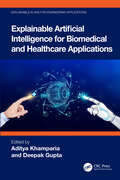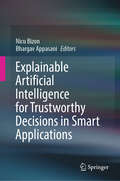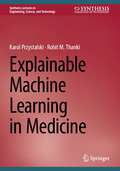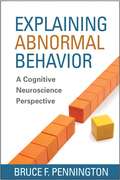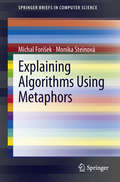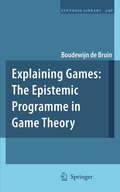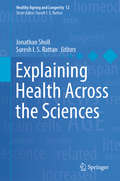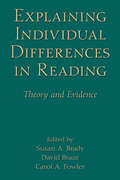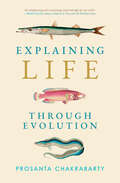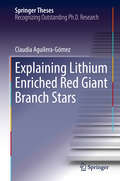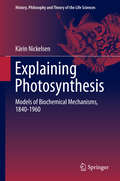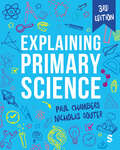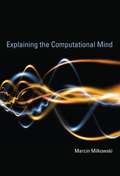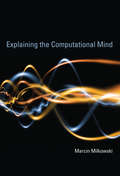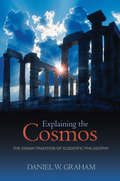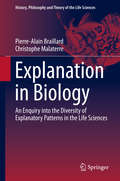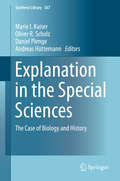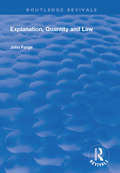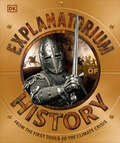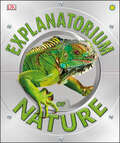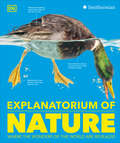- Table View
- List View
Explainable Artificial Intelligence for Biomedical and Healthcare Applications (Explainable AI (XAI) for Engineering Applications)
by Aditya Khamparia and Deepak GuptaThis reference text helps us understand how the concepts of explainable artificial intelligence (XAI) are used in the medical and healthcare sectors. The text discusses medical robotic systems using XAI and physical devices having autonomous behaviors for medical operations. It explores the usage of XAI for analyzing different types of unique data sets for medical image analysis, medical image registration, medical data synthesis, and information discovery. It covers important topics including XAI for biometric security, genomics, and medical disease diagnosis.This book:• Provides an excellent foundation for the core concepts and principles of explainable AI in biomedical and healthcare applications.• Covers explainable AI for robotics and autonomous systems.• Discusses usage of explainable AI in medical image analysis, medical image registration, and medical data synthesis.• Examines biometrics security-assisted applications and their integration using explainable AI.The text will be useful for graduate students, professionals, and academic researchers in diverse areas such as electrical engineering, electronics and communication engineering, biomedical engineering, and computer science.
Explainable Artificial Intelligence for Trustworthy Decisions in Smart Applications
by Nicu Bizon Bhargav AppasaniThis book introduces readers to the field of explainable artificial intelligence (XAI), which aims to make AI models more transparent and trustworthy. It explores how XAI can enhance trust and confidence in AI models and their decisions across various innovative applications in fields such as healthcare, finance, and engineering, where AI can significantly impact quality of life. Readers will discover emerging trends related to XAI—such as large language models, generative AI, and natural language processing—that are transforming the landscape of AI research and applications. Featuring an interdisciplinary overview, the book examines the state of the art, challenges, and opportunities in XAI, accompanied by clear examples and detailed explanations of its methods and techniques. The book also offers a balanced perspective on the limitations and trade-offs of XAI and outlines future directions and opportunities for both research and practice. This book is intended for anyone who wants to learn more about XAI and understand how it can enhance trust in AI models.
Explainable Machine Learning in Medicine (Synthesis Lectures on Engineering, Science, and Technology)
by Karol Przystalski Rohit M. ThankiThis book covers a variety of advanced communications technologies that can be used to analyze medical data and can be used to diagnose diseases in clinic centers. The book is a primer of methods for medicine, providing an overview of explainable artificial intelligence (AI) techniques that can be applied in different medical challenges. The authors discuss how to select and apply the proper technology depending on the provided data and the analysis desired. Because a variety of data can be used in the medical field, the book explains how to deal with challenges connected with each type. A number of scenarios are introduced that can happen in real-time environments, with each pared with a type of machine learning that can be used to solve it.
Explaining Abnormal Behavior
by Bruce F. PenningtonHighly readable and accessible, this book describes how research in cognitive science is transforming the way scientists and clinicians think about abnormal behavior. Bruce Pennington draws on work from multiple disciplines to identify compelling links among psychiatric, neurodevelopmental, and neurological disorders that are not generally studied together. Presenting cutting-edge work on the brain systems involved in key domains of neuropsychological functioning, Pennington sheds light on acquired neurological disorders like aphasia and amnesia, as well as the development of such conditions as schizophrenia, depression, dyslexia, autism, and intellectual disability. The book also reveals how the analysis of both typical and atypical brain-behavior relationships can contribute to a neural explanation of the self and consciousness.
Explaining Abnormal Behavior: A Cognitive Neuroscience Perspective
by Bruce F. PenningtonHighly readable and accessible, this book describes how research in cognitive science is transforming the way scientists and clinicians think about abnormal behavior. Bruce Pennington draws on work from multiple disciplines to identify compelling links among psychiatric, neurodevelopmental, and neurological disorders that are not generally studied together. Presenting cutting-edge work on the brain systems involved in key domains of neuropsychological functioning, Pennington sheds light on acquired neurological disorders like aphasia and amnesia, as well as the development of such conditions as schizophrenia, depression, dyslexia, autism, and intellectual disability. The book also reveals how the analysis of both typical and atypical brain-behavior relationships can contribute to a neural explanation of the self and consciousness.
Explaining Algorithms Using Metaphors
by Michal Forišek Monika SteinováThere is a significant difference between designing a new algorithm, proving its correctness, and teaching it to an audience. When teaching algorithms, the teacher's main goal should be to convey the underlying ideas and to help the students form correct mental models related to the algorithm. This process can often be facilitated by using suitable metaphors. This work provides a set of novel metaphors identified and developed as suitable tools for teaching many of the "classic textbook" algorithms taught in undergraduate courses worldwide. Each chapter provides exercises and didactic notes for teachers based on the authors' experiences when using the metaphor in a classroom setting.
Explaining Games
by Boudewijn De BruinDoes game theory - the mathematical theory of strategic interaction - provide genuine explanations of human behaviour? Can game theory be used in economic consultancy or other normative contexts? Explaining Games: The Epistemic Programme in Game Theory - the first monograph on the philosophy of game theory - is a bold attempt to combine insights from epistemic logic and the philosophy of science to investigate the applicability of game theory in such fields as economics, philosophy and strategic consultancy. De Bruin proves new mathematical theorems about the beliefs, desires and rationality principles of individual human beings, and he explores in detail the logical form of game theory as it is used in explanatory and normative contexts. He argues that game theory reduces to rational choice theory if used as an explanatory device, and that game theory is nonsensical if used as a normative device. A provocative account of the history of game theory reveals that this is not bad news for all of game theory, though. Two central research programmes in game theory tried to find the ultimate characterisation of strategic interaction between rational agents. Yet, while the Nash Equilibrium Refinement Programme has done badly thanks to such research habits as overmathematisation, model-tinkering and introversion, the Epistemic Programme, De Bruin argues, has been rather successful in achieving this aim.
Explaining Health Across the Sciences (Healthy Ageing and Longevity #12)
by Suresh I. S. Rattan Jonathan ShollThis edited volume aims to better understand the multifaceted phenomenon we call health. Going beyond simple views of health as the absence of disease or as complete well-being, this book unites scientists and philosophers. The contributions clarify the links between health and adaptation, robustness, resilience, or dynamic homeostasis, and discuss how to achieve health and healthy aging through practices such as hormesis. The book is divided into three parts and a conclusion: the first part explains health from within specific disciplines, the second part explores health from the perspective of a bodily part, system, function, or even the environment in which organisms live, and the final part looks at more clinical or practical perspectives. It thereby gathers, across 30 chapters, diverse perspectives from the broad fields of evolutionary and systems biology, immunology, and biogerontology, more specific areas such as odontology, cardiology, neurology, and public health, as well as philosophical reflections on mental health, sexuality, authenticity and medical theories. The overarching aim is to inform, inspire and encourage intellectuals from various disciplines to assess whether explanations in these disparate fields and across biological levels can be sufficiently systematized and unified to clarify the complexity of health. It will be particularly useful for medical graduates, philosophy graduates and research professionals in the life sciences and general medicine, as well as for upper-level graduate philosophy of science students.
Explaining Individual Differences in Reading: Theory and Evidence (New Directions in Communication Disorders Research)
by Susan A. Brady David Braze Carol A. FowlerResearch into reading development and reading disabilities has been dominated by phonologically guided theories for several decades. In this volume, the authors of 11 chapters report on a wide array of current research topics, examining the scope, limits and implications of a phonological theory. The chapters are organized in four sections. The first concerns the nature of the relations between script and speech that make reading possible, considering how different theories of phonology may illuminate the implication of these relations for reading development and skill. The second set of chapters focuses on phonological factors in reading acquisition that pertain to early language development, effects of dialect, the role of instruction, and orthographic learning. The third section identifies factors beyond the phonological that may influence success in learning to read by examining cognitive limitations that are sometimes co-morbid with reading disabilities, contrasting the profiles of specific language impairment and dyslexia, and considering the impact of particular languages and orthographies on language acquisition. Finally, in the fourth section, behavioral-genetic and neurological methods are used to further develop explanations of reading differences and early literacy development. The volume is an essential resource for researchers interested in the cognitive foundations of reading and literacy, language and communication disorders, or psycholinguistics; and those working in reading disabilities, learning disabilities, special education, and the teaching of reading.
Explaining Life through Evolution
by Prosanta ChakrabartyA broad overview of the science of evolution, and why understanding it matters in our everyday lives.Explaining Life through Evolution tells the origin story of life on this planet and how we arrived at the tremendous diversity among organisms that we see around us today. Prosanta Chakrabarty explains evolution in a concise, accessible, and engaging way, emphasizing the importance of understanding evolution in everyday contemporary life. Weaving his own lived experience among discussions of Darwin and the origins of evolutionary thought, Chakrabarty also covers key concepts to our understanding of our current condition, including mutation; the spectrum of race, sex, gender, and sexuality; the limitations of ancestry tests; and the evolution of viruses like SARS-CoV-2, the virus at the heart of the COVID-19 pandemic.Offering a contemporary update to classic popular evolution books by Stephen Jay Gould, Jerry Coyne, and others, Explaining Life through Evolution is not only an illuminating read, but also an essential guide to the kind of scientific literacy that we need in order to face the challenges of our collective future.
Explaining Lithium Enriched Red Giant Branch Stars (Springer Theses)
by Claudia Aguilera-GómezThis thesis provides new insights into the seemingly anomalous ubiquity of lithium-rich red giant stars. The theory of stellar evolution, one of the most successful models of modern astrophysics, predicts that red giant stars should display negligible levels of lithium (Li) on their surfaces. However, Li-rich giants, defined as those showing more than three times the Li content of the Sun, are found everywhere astronomers look in apparent defiance of established theory.The author addresses this problem, analyzing the different possible explanations for such an anomaly, which include interaction with a binary companion, the production of Li in the interior of the star with its subsequent transport to stellar exteriors, and the stellar interaction with planets. The author focuses on this last possibility, where the Li enrichment may be due to the ingestion of planets or brown dwarfs as the stars in question grew in size while becoming giants. She shows that this process is indeed able to explain an important fraction of giants with Li levels above the three times solar threshold, but that some other mechanism is needed to explain the remaining fraction. While this is an important discovery in its own right, the result that makes this thesis groundbreaking is its demonstration that the threshold between Li-normal and Li-rich is mass dependent rather than a fixed proportion of the Sun’s content. This corrects a fundamental misapprehension of the phenomenon and opens up a new framework in which to understand and solve the problem.Finally, the author presents interesting observational applications and samples with which to test this new approach to the problem of Li enrichment in giants.
Explaining Photosynthesis
by Kärin NickelsenRecounting the compelling story of a scientific discovery that took more than a century to complete, this trail-blazing monograph focuses on methodological issues and is the first to delve into this subject. This book charts how the biochemical and biophysical mechanisms of photosynthesis were teased out by succeeding generations of scientists, and the author highlights the reconstruction of the heuristics of modelling the mechanism--analyzed at both individual and collective levels. Photosynthesis makes for an instructive example. The first tentative ideas were developed by organic chemists around 1840, while by 1960 an elaborate proposal at a molecular level, for both light and dark reactions, was established. The latter is still assumed to be basically correct today. The author makes a persuasive case for a historically informed philosophy of science, especially regarding methodology, and advocates a history of science whose narrative deploys philosophical approaches and categories. She shows how scientists' attempts to formulate, justify, modify, confirm or criticize their models are best interpreted as series of coordinated research actions, dependent on a network of super- and subordinated epistemic goals, and guided by recurrent heuristic strategies. With dedicated chapters on key figures such as Otto Warburg, who borrowed epistemic fundamentals from other disciplines to facilitate his own work on photosynthesis, and on more general topics relating to the development of the field after Warburg, this new work is both a philosophical reflection on the nature of scientific enquiry and a detailed history of the processes behind one of science's most important discoveries.
Explaining Primary Science
by Paul Chambers Nicholas SouterSuccessful science teaching in primary schools requires a careful understanding of key scientific knowledge. This book covers all the major areas of science relevant for beginning primary school teachers, explaining key concepts from the ground up, helping trainees and recently qualified teachers develop into confident science educators. This new edition comes with: An exploration of scientific misconceptions on key topics How to take action to protect the environment through primary science teaching A newly streamlined focus prioritising essential primary school subject knowledge Links to national curricula for England and Scotland Videos of useful science experiments and demonstrations for the primary classroom
Explaining Primary Science
by Paul Chambers Nicholas SouterSuccessful science teaching in primary schools requires a careful understanding of key scientific knowledge. This book covers all the major areas of science relevant for beginning primary school teachers, explaining key concepts from the ground up, helping trainees and recently qualified teachers develop into confident science educators. This new edition comes with: An exploration of scientific misconceptions on key topics How to take action to protect the environment through primary science teaching A newly streamlined focus prioritising essential primary school subject knowledge Links to national curricula for England and Scotland Videos of useful science experiments and demonstrations for the primary classroom
Explaining the Computational Mind
by Marcin MilkowskiIn this book, Marcin Milkowski argues that the mind can be explained computationally because it is itself computational -- whether it engages in mental arithmetic, parses natural language, or processes the auditory signals that allow us to experience music. Defending the computational explanation against objections to it -- from John Searle and Hilary Putnam in particular -- Milkowski writes that computationalism is here to stay but is not what many have taken it to be. It does not, for example, rely on a Cartesian gulf between software and hardware, or mind and brain. Milkowski's mechanistic construal of computation allows him to show that no purely computational explanation of a physical process will ever be complete. Computationalism is only plausible, he argues, if you also accept explanatory pluralism. Milkowski sketches a mechanistic theory of implementation of computation against a background of extant conceptions, describing four dissimilar computational models of cognition. He reviews other philosophical accounts of implementation and computational explanation and defends a notion of representation that is compatible with his mechanistic account and adequate vis à vis the four models discussed earlier. Instead of arguing that there is no computation without representation, he inverts the slogan and shows that there is no representation without computation -- but explains that representation goes beyond purely computational considerations. Milkowski's arguments succeed in vindicating computational explanation in a novel way by relying on mechanistic theory of science and interventionist theory of causation.
Explaining the Computational Mind
by Marcin MilkowskiA defense of the computational explanation of cognition that relies on mechanistic philosophy of science and advocates for explanatory pluralism. In this book, Marcin Milkowski argues that the mind can be explained computationally because it is itself computational—whether it engages in mental arithmetic, parses natural language, or processes the auditory signals that allow us to experience music. Defending the computational explanation against objections to it—from John Searle and Hilary Putnam in particular—Milkowski writes that computationalism is here to stay but is not what many have taken it to be. It does not, for example, rely on a Cartesian gulf between software and hardware, or mind and brain. Milkowski's mechanistic construal of computation allows him to show that no purely computational explanation of a physical process will ever be complete. Computationalism is only plausible, he argues, if you also accept explanatory pluralism.Milkowski sketches a mechanistic theory of implementation of computation against a background of extant conceptions, describing four dissimilar computational models of cognition. He reviews other philosophical accounts of implementation and computational explanation and defends a notion of representation that is compatible with his mechanistic account and adequate vis à vis the four models discussed earlier. Instead of arguing that there is no computation without representation, he inverts the slogan and shows that there is no representation without computation—but explains that representation goes beyond purely computational considerations. Milkowski's arguments succeed in vindicating computational explanation in a novel way by relying on mechanistic theory of science and interventionist theory of causation.
Explaining the Cosmos: The Ionian Tradition of Scientific Philosophy
by Daniel W. GrahamExplaining the Cosmos is a major reinterpretation of Greek scientific thought before Socrates. Focusing on the scientific tradition of philosophy, Daniel Graham argues that Presocratic philosophy is not a mere patchwork of different schools and styles of thought. Rather, there is a discernible and unified Ionian tradition that dominates Presocratic debates. Graham rejects the common interpretation of the early Ionians as "material monists" and also the view of the later Ionians as desperately trying to save scientific philosophy from Parmenides' criticisms. In Graham's view, Parmenides plays a constructive role in shaping the scientific debates of the fifth century BC. Accordingly, the history of Presocratic philosophy can be seen not as a series of dialectical failures, but rather as a series of theoretical advances that led to empirical discoveries. Indeed, the Ionian tradition can be seen as the origin of the scientific conception of the world that we still hold today.
Explanation in Biology
by Pierre-Alain Braillard Christophe MalaterrePatterns of explanation in biology have long been recognized as different from those deployed in other scientific disciplines, especially that of physics. Celebrating the diversity of interpretative models found in biology, this volume details their varying types as well as explaining their relationships to one another. It covers the key differentials with other sciences in the nature of explanation, such as the existence in biology of varieties unheard of in the physical sciences, such as teleological, evolutionary and even functional explanations. Offering a wealth of fresh analysis of the phenomenon, chapters examine aspects ranging from the role of mathematics in explaining cell development to the complexities thrown up by evolutionary-developmental biology, where explanation is altered by multidisciplinarity itself. They cover major domains such as ecology and systems biology, as well as contemporary trends, such as the mechanistic explanations spawned by progress in molecular biology. With contributions from researchers of many different nationalities, the book provides a many-angled perspective on a revealing feature of the discipline of biology.
Explanation in the Special Sciences
by Andreas Hüttemann Marie I. Kaiser Oliver R. Scholz Daniel PlengeBiology and history are often viewed as closely related disciplines, with biology informed by history, especially in its task of charting our evolutionary past. Maximizing the opportunities for cross-fertilization in these two fields requires an accurate reckoning of their commonalities and differences--precisely what this volume sets out to achieve. Specially commissioned essays by a team of recognized international researchers cover the full panoply of topics in these fields and include notable contributions on the correlativity of evolutionary and historical explanations, applying to history the latest causal-mechanical approach in the philosophy of biology, and the question of generalized laws that might pertain across the two subjects. The collection opens with a vital interrogation of general issues on explanation that apart from potentially fruitful areas of interaction (could the etiology of the causal-mechanical perspective in biology account for the historical trajectory of the Roman Empire?) this volume also seeks to chart relative certainties distinguishing explanations in biology and history. It also assesses techniques such as the use of probabilities in biological reconstruction, deployed to overcome the inevitable gaps in physical evidence on early evolution. Methodologies such as causal graphs and semantic explanation receive in-depth analysis. Contributions from a host of prominent and widely read philosophers ensure that this new volume has the stature of a major addition to the literature.
Explanation in the Special Sciences: The Case of Biology and History (Synthese Library #367)
by Andreas Hüttemann Marie I. Kaiser Oliver R. Scholz Daniel PlengeBiology and history are often viewed as closely related disciplines, with biology informed by history, especially in its task of charting our evolutionary past. Maximizing the opportunities for cross-fertilization in these two fields requires an accurate reckoning of their commonalities and differences—precisely what this volume sets out to achieve. Specially commissioned essays by a team of recognized international researchers cover the full panoply of topics in these fields and include notable contributions on the correlativity of evolutionary and historical explanations, applying to history the latest causal-mechanical approach in the philosophy of biology, and the question of generalized laws that might pertain across the two subjects. The collection opens with a vital interrogation of general issues on explanation that apart from potentially fruitful areas of interaction (could the etiology of the causal-mechanical perspective in biology account for the historical trajectory of the Roman Empire?) this volume also seeks to chart relative certainties distinguishing explanations in biology and history. It also assesses techniques such as the use of probabilities in biological reconstruction, deployed to overcome the inevitable gaps in physical evidence on early evolution. Methodologies such as causal graphs and semantic explanation receive in-depth analysis. Contributions from a host of prominent and widely read philosophers ensure that this new volume has the stature of a major addition to the literature.
Explanation, Quantity and Law (Routledge Revivals)
by John ForgePublished in 1999, this work sets out to give an account of explanation which is adequate to the problems that arise when looking at physical science. It offers a theory of explanation with supporting analysis, and also an application to the task of giving an account of explanation in quantum mechanics.
Explanatorium of History: From the First Tools to the Climate Crisis (DK Explanatorium)
by DKDiscover the story of &“us&” — from the dawn of human history up to the world we live in today.This visually stunning history encyclopedia for children takes you on an epic fact-packed journey through the past. Explore historical events through vivid illustrations and engaging explanations.Inside the pages of this fascinating history book for kids ages 10-14, you&’ll find: • Gorgeous images of objects, paintings and landscapes that bring history to life. • In-depth information using targeted captions and annotation. • Supporting artwork panels allow for a deeper understanding. • Comprehensive historical reference. Welcome to the SI Explanatorium. Take a look inside to reveal how history works! From the evolution and migrations of early humans to the rise and fall of great empires like Ancient Rome and the Aztecs, this history reference book shows you the major turning points in history.Get the inside track on wars and conflict, including European knights, Japanese samurai, Inca warriors and the major clashes of World War I, World War II, the Cold War, the War on Terror and so much more. It&’s the perfect children&’s visual encyclopedia for young history buffs.There are more SI Explanatoriums to explore! Get closer to nature than you&’ve ever been before with SI Explanatorium of Nature and see the world of science come to life with SI Explanatorium of Science.
Explanatorium of Nature (DK Explanatorium)
by DKGet closer to nature than you&’ve ever been before with this jaw-dropping guide to our wonderful world. Marvel at the breathtaking photography showcasing flora and fauna in the most incredible, intricate detail. From ants to elephants, the animal kingdom is explored and explained in this extraordinary encyclopedia that puts you at the heart of the action. See the tiny spines on a stinging nettle, watch lichen spreading over a tree, and observe the secret suckers on an iguana&’s feet. The mysteries of the natural world are displayed in brand new images, together with cross-sections, macro, and electron microscope images. Alongside the utterly absorbing visual content, Explanatorium of Nature brings its own fountain of knowledge about how nature works. For instance, did you know baby foxes that are born with blue eyes turn to gold? Or that reptile scales are made from the same material as your fingernails? Discover how spiders spin webs, how birds fly, how snakes kill, and much, much more. This irresistible book is a guaranteed favorite for animal lovers, nature enthusiasts, and budding wildlife experts everywhere.
Explanatorium of Nature: Where the Wonders of the World are Revealed (DK Explanatorium)
by DKGet closer to nature than you’ve ever been before with this jaw-dropping guide to our wonderful world. Marvel at the breathtaking photography showcasing flora and fauna in the most incredible, intricate detail. From ants to elephants, the animal kingdom is explored and explained in this extraordinary encyclopedia that puts you at the heart of the action. See the tiny spines on a stinging nettle, watch lichen spreading over a tree, and observe the secret suckers on an iguana’s feet. The mysteries of the natural world are displayed in brand new images, together with cross-sections, macro, and electron microscope images. Alongside the utterly absorbing visual content, Explanatorium of Nature brings its own fountain of knowledge about how nature works. For instance, did you know baby foxes that are born with blue eyes turn to gold? Or that reptile scales are made from the same material as your fingernails? Discover how spiders spin webs, how birds fly, how snakes kill, and much, much more. This irresistible book is a guaranteed favorite for animal lovers, nature enthusiasts, and budding wildlife experts everywhere.
